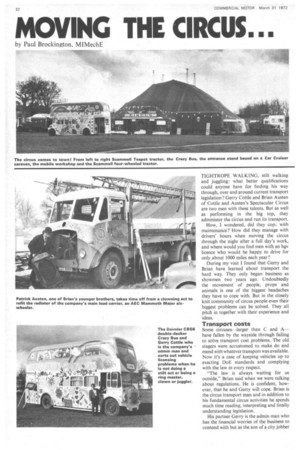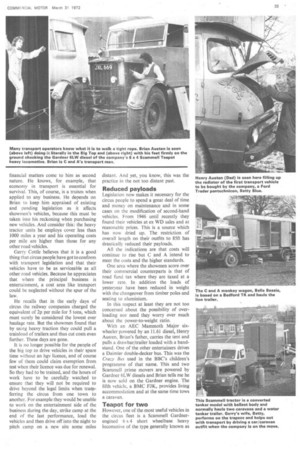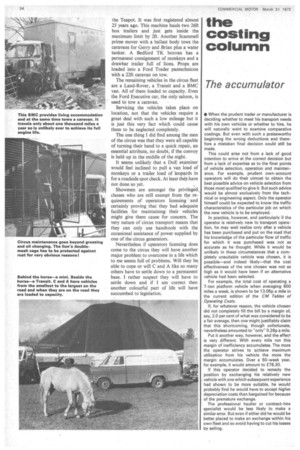MOVING THE CIRCUS...
Page 34

Page 35

Page 36

If you've noticed an error in this article please click here to report it so we can fix it.
by Paul Brockington, MIMechE
TIGHTROPE WALKING, stilt walking and juggling: what better qualifications could anyone have for finding his way through, over and around current transport legislation ? Gerry Cottle and Brian Austen of Cottle and Austen's Spectacular Circus are two men with these talents, But as well as performing in the big top, they administer the circus and run its transport.
How, I wondered, did they copc with maintenance? How did they manage with drivers' hours when moving the circus through the night after a full day's work, and where would you find men with an hgv licence who would be happy to drive for only about 1000 miles each year?
During my visit I found that Gerry and Brian have learned about transport the hard way. They only began business as showmen two years ago. Undoubtedly the movement of people, props and animals is one of the biggest headaches they have to cope with. But in the closely knit community of circus people even their biggest problems can be solved. They all pitch in together with their experience and ideas.
Transport costs
Some circuses—larger than C and A— have fallen by the wayside through failing to solve transport cost problems. The old stagers were accustomed to make do and mend with whatever transport was available. Now it's a case of keeping vehicles up to exacting DoE standards and complying with the law in every respect.
"The law is always waiting for us outside," Brian said when we were talking about regulations. He is confident, however, that he and Gerry will cope. Brian is the circus transport man and in addition to his fundamental circus activities he spends much time reading, interpreting and finally understanding legislation.
His partner Gerry is the admin man who has the financial worries of the business to contend with but as the son of a city jobber financial matters come to him as second nature. He knows, for example,. that economy in transport is essential for survival. This, of course, is a truism when applied to any business. He depends on Brian to keep him appraised of existing and pending legislation as it affects showmen's vehicles, because this must be taken into his reckoning when purchasing new vehicles. And consider this: the heavy tractor units he employs cover less than 1000 miles a year and his operating costs per mile are higher than those for any other road vehicles.
Gerry Cottle believes that it is a good thing that circus people have got to conform with transport legislation and that their vehicles have to be as serviceable as all other road vehicles. Because he appreciates that where the principal business is entertainment, a cost area like transport could be neglected without the spur of the law.
He recalls that in the early days of circus the railway companies charged the equivalent of 2p per mile for 5 tons, which must surely be considered the lowest ever haulage rate. But the showmen found that by using heavy traction they could pull a trainload of trailers and thus cut costs even further. These days are gone.
It is no longer possible for the people of the big top to drive vehicles in their spare time without an hgv licence, and of course few of them could claim exemption from test when their licence was due for renewal. So they had to be trained, and the hours of work have to be carefully watched to ensure that they will not be required to drive beyond the legal limits when transferring the circus from one town to another. For example they would be unable to work on the entertainment side of the business during the day, strike camp at the end of the last performance, load the vehicles and then drive off into the night to pitch camp on a. new site some miles distant. And yet, you know, this was the practice in the not too distant past.
Reduced payloads
Legislation now makes it necessary for the circus people to spend a great deal of time and money on maintenance and in some cases on the modification of second-hand vehicles. From 1946 until recently they found their vehicles at ex WD sales and at reasonable prices. This is a source which has now dried up. The restriction of overall length on their outfits to 85ft has drastically reduced their payloads.
All the indications are that costs will continue to rise but C and A intend to meet the costs and the higher standards.
One area where the showmen score over their commercial counterparts is that of road fund tax where they are taxed at a lower rate. In addition the loads of yesteryear have been reduced in weight with the changeover from timber poles and seating to aluminium.
In this respect at least they are not too concerned about the possibility of overloading nor need they worry over much about the power-to-weight ratio.
With an AEC Mammoth Major sixwheeler powered by an 11.61 diesel., Henry Austen, Brian's father, carries the tent and pulls a drawbar/trailer loaded with a bandstand. One of the other entertainers drives a Daimler double-decker bus. This was the Crazy Bus used in the BBC's children's programme of that name. This and two Scammell prime movers are powered by Gardner 6LW diesels and Brian tells me he is now sold on the Gardner engine. The fifth vehicle, a BMC FJK, provides living accommodation and at the same time tows a caravan.
Teapot for two
However, one of the most useful vehicles in the circus fleet is a Scammell Gardnerengined 6 x 4 short wheelbase heavy locomotive of the type generally known as the Teapot. It was first registered almost 25 years ago. This machine hauls two 26ft box trailers and just gets inside the maximum limit by 2ft. Another Scammell prime mover with a ballast body tows the caravans for Gerry and Brian plus a water tanker. A Bedford TK boxvan has a permanent consignment of monkeys and a drawbar trailer full of lions. Props are loaded into a Ford Trader pantechnicon with a 22ft caravan on tow.
The remaining vehicles in the circus fleet are a Land-Rover, a Transit and a BMC van. All of them loaded to capacity. Even the Ford Executive car, the only saloon, is used to tow a caravan.
Servicing the vehicles takes place on location, not that the vehicles require a great deal with such a low mileage but it is just this very fact which could cause them to be neglected completely.
The one thing I did find among the men of the circus was that they were all capable of turning their hand to a quick repair, an essential attribute, no doubt, if the convoy is held up in the middle of the night.
It seems unlikely that a DoE examiner would feel inclined to pull a van load of monkeys or a trailer load of leopards in for a roadside spot check. At least they have not done so yet.
Showmen are amongst the privilege classes who are still exempt from the requirements of operators licensing and certainly proving that they had adequate facilities for maintaining their vehicles might give them cause for concern. The very nature of circus transport means that they can only use handtools with the occasional assistance of power supplied by one of the circus generators.
Nevertheless if operators licensing does come to the circus they will have another major problem to overcome in a life which to me seems full of problems. Will they be able to cope or will C and A like so many others have to settle down to a permanent base. I rather suspect they will have to settle down and if I am correct then another colourful part of life will have succumbed to legislation.




















































































